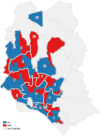Impact evaluation of contracting primary health care services in urban Bangladesh
- PMID: 31752843
- PMCID: PMC6956513
- DOI: 10.1186/s12913-019-4406-5
Impact evaluation of contracting primary health care services in urban Bangladesh
Abstract
Background: The Urban Primary Health Care Project (UPHCP) was implemented by the Government of Bangladesh in response to rapid urbanization and growing inequalities in access to and quality of primary health care. The goal of the project was to improve health status of the urban poor living in city corporations and municipalities through the provision of health care services by NGOs that are contracted through public-private partnership. The first phase of the project started in 1998 and the project is currently in its fourth phase covering more urban areas than the first three phases. This study evaluates the impact of the second phase project (UPHCP-II) on health outcomes, mainly child diarrhea, acute respiratory infection, antenatal and postnatal care, skilled birth attendance, breastfeeding prevalence, contraceptive prevalence, sexually transmitted infections, and HIV/AIDS awareness.
Methods: The effect of the project was estimated through propensity score matching between project and non-project areas comparing baseline and endline surveys over a six-year period from 2006 to 2012. An innovation of this study is the recalibration of the sampling weights that allows the use of these two independent surveys in impact evaluation.
Results: Over the six-year period, UPHCP-II improved the health status of the population in project areas compared to non-project areas. The study found significant improvement in health outcomes in terms of reduced diarrhea and acute respiratory infection in children, which explains the downward trend in child mortality rate. Moreover, the project also improved antenatal care and skilled birth attendance. Contraceptive prevalence and HIV/AIDS awareness and avoidance increased, and sexually transmitted infections decreased.
Conclusions: UPHCP-II was effective in achieving its health outcome targets, while previous studies show that it was efficient in the delivery of health care and clients were highly satisfied because health facilities were in close proximity, and doctors and staff were perceived as responsive in delivering high quality of care. The results of this study could help inform future design and implementation of urban health interventions that involve contracting primary health care service delivery in Bangladesh and other similar settings.
Keywords: Bangladesh; Contracting; Impact evaluation; Maternal and child health; Primary health care; Propensity score matching; UPHCP-II; Urban health.
Conflict of interest statement
MLA was a consultant for Asian Development Bank and contributed to the impact evaluation research. SKB is from the National Institute of Population Research and Training, Bangladesh—the institution that administered the baseline and endline surveys. BC is an Asian Development Bank official and managed the project during the closing stage. The findings, interpretations, and conclusions expressed in this study are entirely those of the authors. They do not necessarily represent the views and policies of the Asian Development Bank or its Board of Governors or the governments they represent.
Figures








Similar articles
-
Making doctors stay: Rethinking doctor retention policy in a contracted-out primary healthcare setting in urban Bangladesh.PLoS One. 2022 Jan 5;17(1):e0262358. doi: 10.1371/journal.pone.0262358. eCollection 2022. PLoS One. 2022. PMID: 34986200 Free PMC article.
-
Who serves the urban poor? A geospatial and descriptive analysis of health services in slum settlements in Dhaka, Bangladesh.Health Policy Plan. 2015 Mar;30 Suppl 1(Suppl 1):i32-45. doi: 10.1093/heapol/czu094. Health Policy Plan. 2015. PMID: 25759453 Free PMC article.
-
Contracting urban primary healthcare services in Bangladesh - effect on use, efficiency, equity and quality of care.Trop Med Int Health. 2013 Jul;18(7):861-70. doi: 10.1111/tmi.12113. Epub 2013 Apr 24. Trop Med Int Health. 2013. PMID: 23611146
-
Reduction of maternal and perinatal mortality in rural and peri-urban settings: what works?Eur J Obstet Gynecol Reprod Biol. 1996 Oct;69(1):47-53. doi: 10.1016/0301-2115(95)02535-9. Eur J Obstet Gynecol Reprod Biol. 1996. PMID: 8909956 Review.
-
Community health outreach program of the Chad-Cameroon petroleum development and pipeline project.Clin Occup Environ Med. 2004 Feb;4(1):9-26. doi: 10.1016/j.coem.2003.09.004. Clin Occup Environ Med. 2004. PMID: 15043361 Review.
Cited by
-
The Awareness and Attitude of Contracted Service Among General Medical Practitioners in Community Health Service Centers in Urban China: A Cross-Sectional Study.Front Public Health. 2021 Jun 8;9:572311. doi: 10.3389/fpubh.2021.572311. eCollection 2021. Front Public Health. 2021. PMID: 34169052 Free PMC article.
-
Community participation and contracting between state and non-state actors in primary care: A scoping review of evidence.Int J Equity Health. 2025 Jul 9;24(1):199. doi: 10.1186/s12939-025-02567-3. Int J Equity Health. 2025. PMID: 40634992 Free PMC article.
-
NGOs' initiatives and grassroots approach for accessing to health care services for the slum people in Dhaka.Front Health Serv. 2024 Sep 19;4:1386698. doi: 10.3389/frhs.2024.1386698. eCollection 2024. Front Health Serv. 2024. PMID: 39364142 Free PMC article.
-
Understanding urban inequalities in children's linear growth outcomes: a trend and decomposition analysis of 39,049 children in Bangladesh (2000-2018).BMC Public Health. 2021 Nov 30;21(1):2192. doi: 10.1186/s12889-021-12181-x. BMC Public Health. 2021. PMID: 34847918 Free PMC article.
-
Impact of health system governance on healthcare quality in low-income and middle-income countries: a scoping review.BMJ Open. 2023 Dec 11;13(12):e073669. doi: 10.1136/bmjopen-2023-073669. BMJ Open. 2023. PMID: 38081664 Free PMC article.
References
-
- Bangladesh Bureau of Statistics (BBS). Bangladesh Population and Housing Census 2011 – National Report, Volume 4. Dhaka; 2012.
-
- United Nations . Department of Economic and Social Affairs, population division. New York: World Urbanization Prospects: The 2014 Revision; 2014.
-
- National Institute of Population Research and Training (NIPORT), MEASURE Evaluation, International Centre for Diarrhoeal Disease Research, Bangladesh, and Associates for Community and Population Research. 2006 Bangladesh Urban Health Survey. Dhaka; 2008.
-
- National Institute of Population Research and Training, Mitra and Associates, and macro international. Bangladesh demographic and health survey 2007. Dhaka; 2009.
MeSH terms
LinkOut - more resources
Full Text Sources

